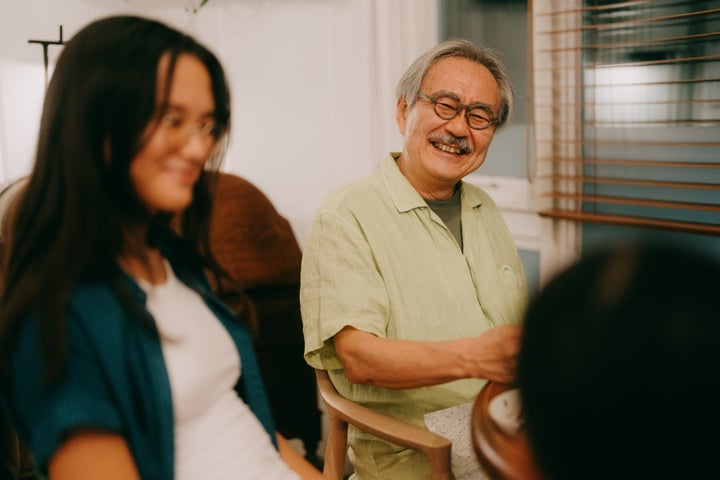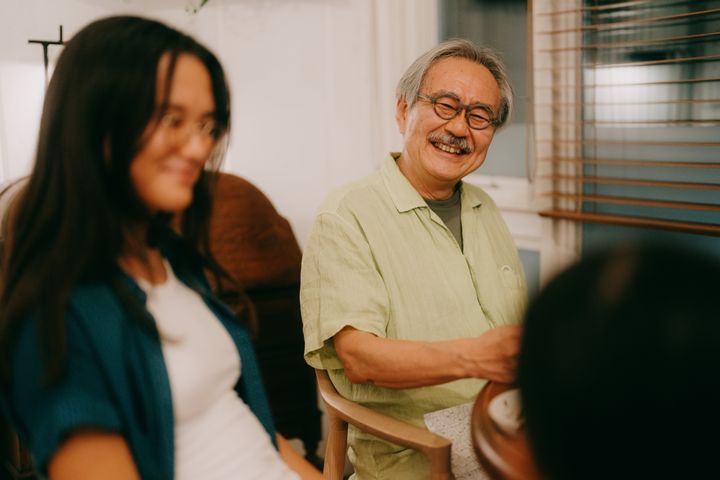During certain times of the day, some people with dementia may become more confused and disoriented. Referred to by neuropsychologist April Krowel as “a constellation of symptoms rooted in confusion and disorientation,” this condition is called ”sundowning.”
“Typically, people will start to experience the symptoms in the late afternoon, early evening, the time when the sun is setting,” Krowel, who specializes in assessments of adults with neurological disorders, told HuffPost.
Sometimes, the symptoms occur quite late into the evening, said Dr. Victor Diaz, a neurologist at Orlando Health Neuroscience Institute.
Approximately 1 in 5 people with dementia experience sundowning. It affects people with different forms of dementia, like Alzheimer’s and Lewy body dementia, Diaz said. “Episodes can last anywhere from a few minutes to a few hours, and in some cases, can extend into the night.”
Sundowning is not something that a person with dementia may notice in themselves, Krowel noted. Rather, it is typically caregivers who pick up on the change in their loved one’s behavior and mental state. It can happen at any stage of dementia, though it “tends to peak in the middle stages of dementia and lessens as the disease progresses,” according to the Alzheimer Society of Canada.
The symptom is distressing for the person experiencing it. “They don’t know where they are, where they live, they don’t feel safe, which creates an anxiety within them, which can lead to restlessness and irritability,” Krowel explained. They may also experience difficulties with sleeping, Diaz said.
There are ways to manage these symptoms so the person with dementia feels more at ease. Ahead, experts share how to identify sundowning, and how to best support a person going through it:
Why does sundowning happen in dementia?
To date, no clear cause of sundowning has been identified, both experts said. Some researchers believe it partly has to do with a disrupted circadian rhythm. Almost every tissue in your body follows a circadian rhythm, which is the body’s internal clock. This process follows the cycle of day and night, to prime your body for alertness in the day and sleepiness at night.
When disrupted in dementia, it can potentially cause a person to have increased physical activity later during the day, or remain awake for longer after the sun sets. A 2020 paper noted that circadian rhythms can play a role in influencing emotions and moods. Researchers are still trying to pinpoint exactly what is happening in the brain to affect the circadian rhythm in dementia.
In addition to the above, if a person has afternoon fatigue, pain, hunger, inadequate exposure to sunlight during the day, anxiety, depression, side effects from medications, hearing loss or sight impairment, these may increase their likelihood of experiencing sundowning.
What are the signs of sundowning?
Disorientation and confusion underpin most of the other sundowning symptoms and behaviors. As the day is ending, people may start to be uncertain and confused about what’s going on in their environment.
“For example, if their family is preparing dinner, the patient might be thinking, ‘What are these people doing?’ They don’t understand the activity around preparing the meal,” Diaz said. They may also feel that they are in the wrong place.
Because of this, they may become agitated and restless. “They might pace around or rock in the chair, things like that, where there’s visibility, an inability to relax,” Krowel said.
The person may become anxious, irritable, upset or aggressive. They may also have difficulty falling asleep or staying asleep, Diaz said. “Relatives may say they observe the patient wandering at night, because they’re not sleeping at night and reversing the day with the night.”
Symptoms “present differently from patient to patient, because there is more than one form of dementia,” Diaz noted. Visual or auditory hallucinations are more common in those with Lewy body Dementia, for example.
It’s important to learn to tell sundowning apart from delirium, though, as symptoms can appear similar.
Delirium may mean the person is going through a condition that is critical and in some cases, life-threatening, so being able to identify its root cause is essential. “Disorientation in delirium [may mean] the patient is in a critical condition. It could be a bad infection, sepsis, a severe and sudden spike in blood pressure, very high blood sugar, or a manifestation of stroke in patients who are older,” Diaz said.
The main way to distinguish between delirium and sundowning is by remembering that the latter typically occurs around the time the sun is setting or at a specific time of day, whereas delirium occurs abruptly at any time of the day, Diaz explained.
“For the most part, once you find out what is causing the delirium, and treat it or get it under control, the delirium will subside,” he noted. Sundowning tends to recur, though there are ways to ease its symptoms when it does.
If you suspect your loved one is experiencing delirium, Krowel advised seeing your primary care physician or going to emergency care, “depending on how severe the symptoms are at the time.”

Ippei Naoi via Getty Images
What can worsen sundowning?
Below, Diaz and Krowel shared a list of common factors that can worsen sundowning, and their advice to ease it.
Before running through this list with your loved one, it is a good idea to make sure all of the person’s basic needs are met first: Could they be hungry? Thirsty? Uncomfortable? Tired? They may be agitated because of an unmet need, Krowel said.
Lack of routines and changing the environment.
“When you don’t have any routines, move furniture or objects around, change the person’s caregiver, or introduce any other new developments, this disorients the person more,” Diaz said.
Krowel and Diaz advise creating a steady daily routine, sticking to it and minimizing changes to a person’s living environment. Take familiar, comforting objects, like photographs of family, along if the person is going somewhere new and out of their usual routine, as these can help to ground them and make them feel more at ease, Krowel said.
Certain types of medications and timing of medications.
Narcotics and certain psychotropic drugs can exacerbate sundowning symptoms, Diaz said. In general, psychotropic drugs to stay away from include anticholinergic and benzodiazepine medications. If the person needs a drug to manage their pain, Diaz recommended staying away from narcotics, and consulting your treating physician for alternatives.
Diaz also said that sometimes the timing and dosing of medications can exacerbate symptoms of sundowning. If you’re noticing symptoms worsening, start to keep track of the person’s medications, “what time you’re giving the medication, what you’re doing differently, and report this to your primary care doctor.”
It may be worth having a medication review done by a physician to make sure your prescribed drugs aren’t worsening your sundowning symptoms, Krowel noted.
Poor management of pain, stress or anxiety.
Pain, stress and anxiety can worsen the symptoms of sundowning, Krowel noted.
Monitor the person for any signs that they are in pain, experiencing stress or are anxious, and seek the input of the treating physician and neuropsychologist on how to manage these appropriately.
Poorly lit environment and sight impairment.
“As we get older, we tend to have problems like cataract or diminished visual acuity, so good lighting is very important. If you have a poorly lit place, patients can have a lot of difficulty seeing objects, which can lead to confusion. If the person has visual problems, make sure that these are addressed as well,” Diaz said.
As it gets darker outside, make sure the person’s room is well-lit with artificial lights and lamps so they can see their surroundings clearly. At night, it may be helpful to install a small night light.
Overstimulating environments, especially in the late afternoon.
“Environments that are too noisy can hyperstimulate the patient and overwhelm them,” Diaz said. “And that can lead to them becoming more agitated, confused, and even afraid.”
“After around 5 in the afternoon, it’s important to create an environment that is calm, low noise, and comfortable so the person won’t be overstimulated,” Diaz added. Noise can be everything from music and television to conversations and clattering of cutlery.
Lack of exposure to sunlight during the daytime.
Sunlight helps to regulate the circadian rhythm and prepares the body to sleep when it turns dark. “Having a lack of exposure to sunlight is something that research shows might worsen sundowning symptoms,” Krowel said.
As much as possible, make sure the person is exposed to sunlight during the daytime, whether it is sitting by a window or walking outside.
Lack of sleep and fatigue.
Tiredness and sleep difficulties worsen the severity of sundowning.
If the person is having sleep difficulties at night, sometimes introducing a melatonin supplement around 5 p.m. can be helpful for some patients, according to Diaz. Melatonin, a hormone which helps maintain the circadian rhythm and causes sleepiness at night, has been found to be lower in individuals with Alzheimer’s dementia. Make sure to check with a physician before starting this, however.
He also recommended correcting any issues that can disrupt sleep, like obstructive sleep apnea, and avoiding excessive caffeine or sugar as these can be stimulating.
Lack of interaction.
“One way that families might deal with sundowning is by leaving the person alone in their bedroom until they finish having their episode. That is not advisable, because the more isolated the patient is, it feeds into their fear and anxiety and disorientation,” Diaz said.
Instead, he advised calmly redirecting the person. “When the person becomes agitated or disoriented, say ‘You are in: [insert name of where they are]. This is what we are doing: [insert explanation of what is happening].’ This reassures the person and explains in that moment what is going on, which helps you avoid the cycle of the person becoming disoriented, anxious and agitated.”


